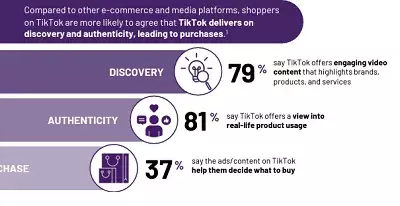In light of the recent controversies surrounding TikTok’s status in the U.S., a new survey conducted by TikTok in collaboration with Ipsos provides crucial insights into the potential of the platform as a tool for product discovery and eCommerce. The survey, which sampled 3,876 internet users across the United States, highlights an evolving landscape for shopping habits and the role TikTok may play in it. The timing of this report is particularly poignant, as discussions about TikTok’s future in the country intensify.
The survey underscores TikTok’s potential effectiveness as a product discovery engine. With the rise of influencer culture, users are increasingly turning to creators on the platform for recommendations. These influencers, who often have substantial follower bases, share insights and showcase products in a manner that feels authentic to their audience. This dynamic helps create a unique shopping experience that differs markedly from traditional eCommerce websites or even other social media platforms.
TikTok’s design, which emphasizes short, engaging video content, allows creators to demonstrate products in creative ways. This visual storytelling approach not only captures attention but also facilitates deeper engagement with potential buyers. The survey results indicate that users find the platform to be a valuable resource for product insights, influencing their purchasing decisions significantly. As this trend continues to grow, the implications for retailers looking to tap into TikTok’s user base are profound.
Another core finding from the report is TikTok’s unique positioning in terms of user sentiment when compared to other platforms. The platform’s community-centric model fosters a more organic connection between product creators and consumers, which may lead to greater trust and, consequently, higher conversion rates. Users reportedly feel more inclined to explore new products on TikTok than on traditional eCommerce platforms, which might feel more sterile or commercialized.
The comparative analysis reflects a shift in how brands are perceived in the digital space. TikTok not only democratizes the promotion of products through everyday users but allows smaller brands to gain significant visibility. This offers a critical opportunity for retailers to rethink their marketing strategies, aiming to blend creative content with eCommerce effectively.
The survey reveals a notable trend: user engagement with TikTok’s shopping features is on the rise, with a corresponding increase in the willingness to spend. While TikTok has yet to become a dominant force in the online selling arena, the data suggests a significant shift in user behavior. As consumers become more comfortable with buying products directly through TikTok listings, the platform has the potential to unbundle the conventional shopping experience.
This shift is significant, particularly since TikTok has not yet reached the eCommerce heights of its Chinese counterpart, Douyin. However, the rapid increase in spending and product exploration behaviors indicates that TikTok could soon become an influential player in the U.S. commerce narrative, provided it can navigate the prevailing regulatory challenges.
For retailers eyeing the TikTok landscape, the survey presents several actionable strategies. Businesses must recognize the importance of engaging with TikTok’s creative community, leveraging influencer partnerships, and creating authentic content that resonates with their target audience. It is imperative for retailers to understand that TikTok thrives on creativity, spontaneity, and relatability, thus requiring a shift from traditional advertising methods to more immersive marketing strategies.
However, this landscape is fraught with uncertainty due to the impending potential removal of TikTok from the U.S. market. The complicated geopolitical climate has cast a shadow over the platform’s future. While some proposals, such as a sale to a U.S. company, remain on the table, the ultimate outcome remains unpredictable. Retailers must remain agile, ready to adapt their strategies based on TikTok’s status in the U.S.
As TikTok navigates turbulent waters, the insights gleaned from this survey offer a glimpse into the platform’s potential as a commerce entity. Should TikTok manage to stay operational in the U.S., brands must reconsider their approach to marketing, embracing the unique characteristics of the platform. Conversely, should it be forced to exit, much of this valuable data may become moot. Nevertheless, as the digital economy evolves, the adaptation and engagement strategies outlined in this report could serve as a roadmap for retailers in a world increasingly driven by social media commerce. The coming months will be crucial in determining the next chapter for TikTok in America.

